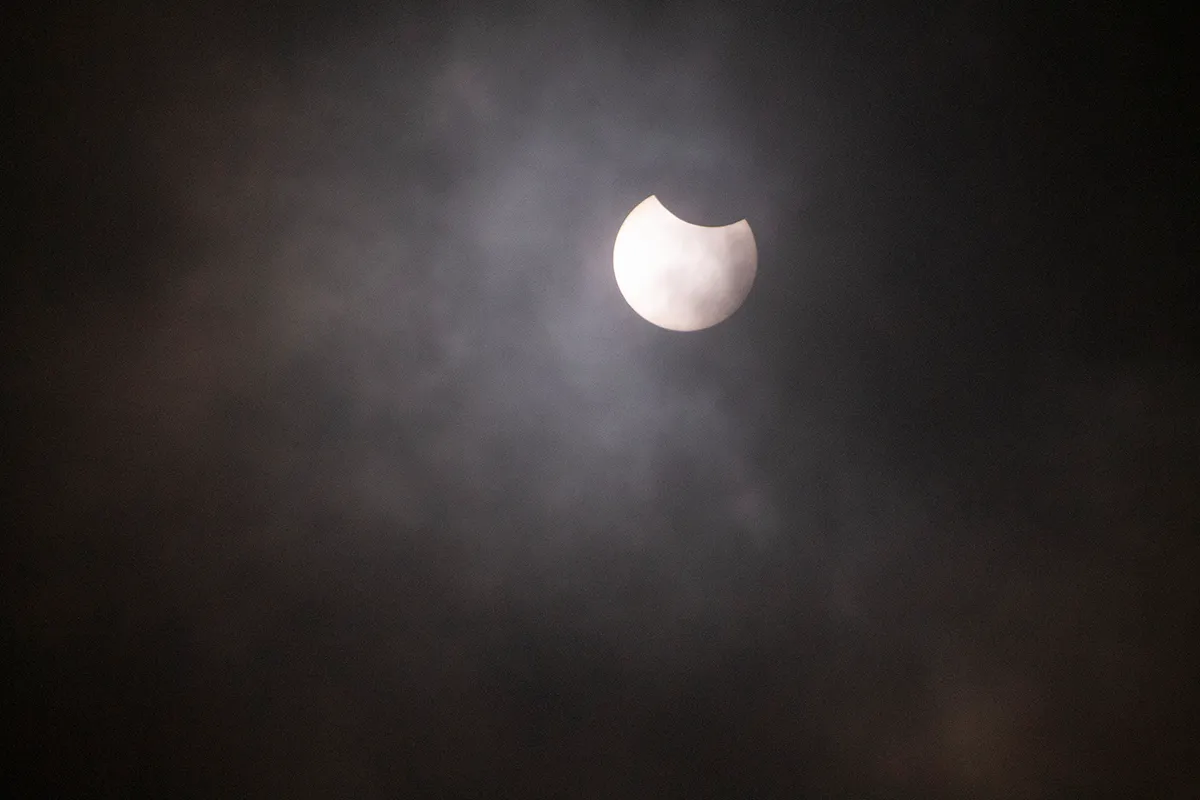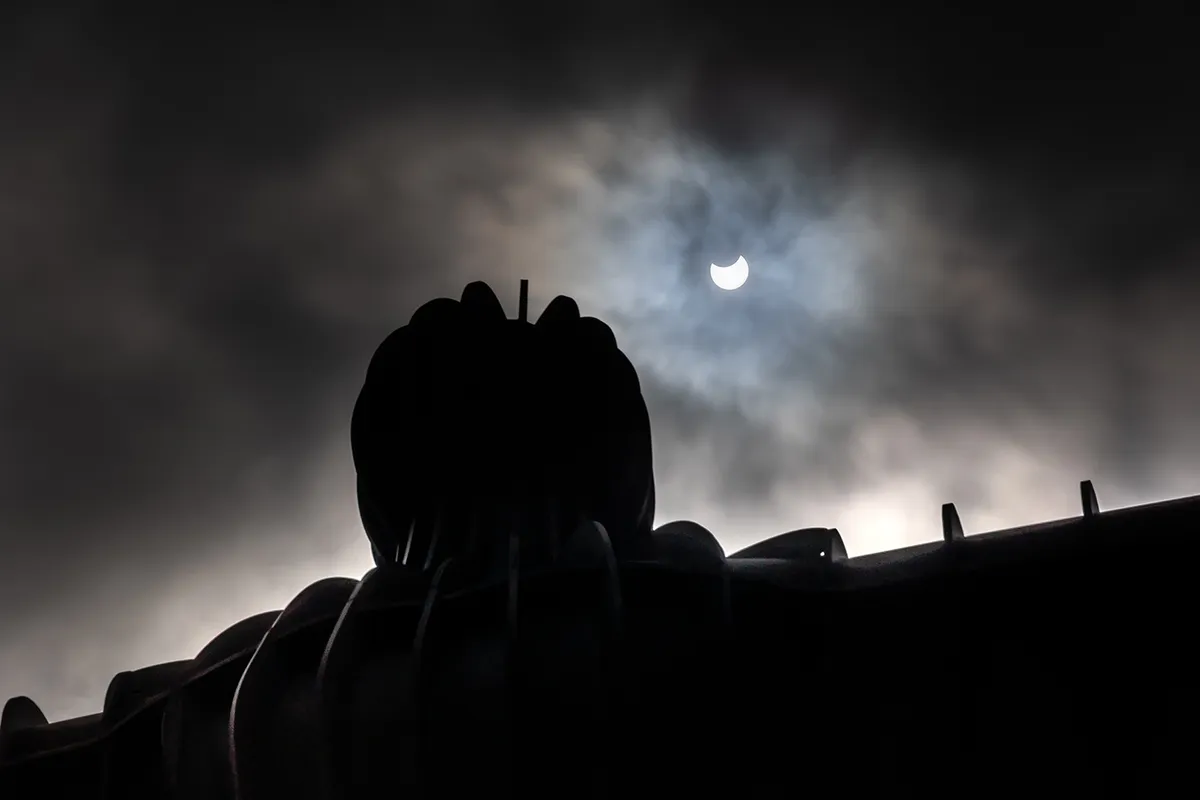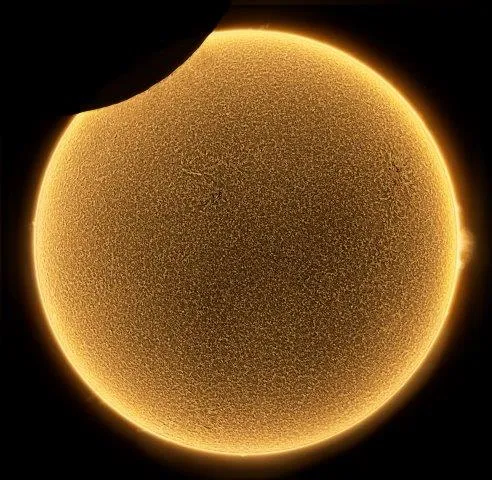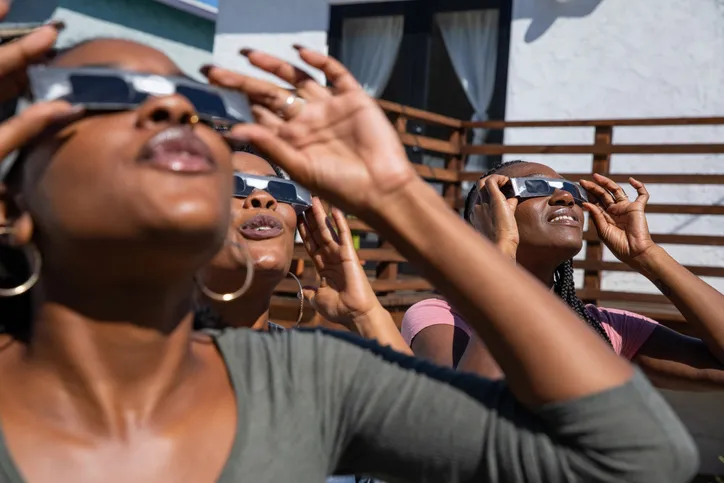The Moon will pass in front of a part of the Sun tomorrow morning, 25 October 2022, in an event that will result in a partial solar eclipse.
This solar eclipse will be visible from much of Europe, as well as north Africa, the Middle East and western Asia. It will not be visible from the US, Canada, south American countries or Australia.
From the UK, the best time to see the eclipse will be from 10:00 BST (09:00 UT) until 12:00 BST (11:00 UT).
But remember, observing the Sun with the naked eye can seriously damage your eyesight, so proper solar filters or eclipse glasses must be worn.
Or you could try solar projection. For full advice, read on...
Find out when the next eclipse is taking place
What is a partial solar eclipse?

Partial solar eclipses happen when, from a particular location on Earth, only part of the Sun’s disc is covered by the Moon’s disc.
Technically, during such an eclipse, it’s the Moon’s penumbral shadow passing over us.
The amount of the Sun’s disc that is covered is described by two quantities: eclipse magnitude and obscuration.
Eclipse magnitude describes how far the eclipsing body extends over the diameter of the object being eclipsed.
For example, if the Moon’s edge reached the mid-point of the Sun at the point of maximum eclipse, this would be described as a partial eclipse of magnitude 50%; the Moon covers half the Sun’s apparent diameter.
Eclipse obscuration describes how much area is covered.
In our example, where the Moon moves to a position where its edge touches the centre of the Sun’s disc, the obscuration would be 39.1%, assuming the apparent diameter of the Sun and Moon were the same.
In practice there are small differences between the apparent size of the Sun and Moon caused by the elliptical orbit of the Moon around Earth and the elliptical orbit of Earth around the Sun.
When and where to see the 25 October eclipse

The 25 October partial solar eclipse favours those living further east and to a lesser extent, further north.
From Truro in Cornwall the event starts at 10:12 BST (09:12 UT) and ends at 11:38 BST (10:38 UT), a total duration of 86 minutes.
The maximum magnitude of the Truro eclipse is 17.66% and obscuration is 8.65%.
From Birmingham the eclipse starts at 10:07 BST (09:07 UT) and runs for 101 minutes, with maximum magnitude 25.65% and 14.95% obscuration.
York’s starts at 10:06 BST (09:06 UT), lasts for 106 minutes, and shows a maximum magnitude of 29.29% and obscuration of 18.13%.
From the northeast tip of Shetland it begins at 10:01 BST (09:01 UT), runs for almost two hours, shows a maximum magnitude of 40.96%, while the obscuration is 29.38%.
How to watch the solar eclipse online
The Royal Observatory Greenwich will be live-streaming the partial solar eclipse via the Annie Maunder Astrographic Telescope. The livestream is presented by ROG astronomer Jake Foster, so even if visibility is poor you can still catch up on what's going on.
Watch the eclipse via the view below.
What you'll see

Partial solar eclipses, as their name suggests, don’t cover the Sun’s disc completely. As the greatest coverage will only be 24.5% at best from mainland UK, the area of Sun that remains visible will pose a danger to eyesight and equipment.
Consequently, great care needs to be taken to protect both.
A partial solar eclipse lacks the majesty of a total eclipse.
The effects that people spend thousands of pounds on chasing to remote parts of the world are absent during a partial.

Although it does have additional interest, the same is largely true for an annular eclipse, where the Moon moves in front of the Sun but its apparent size is too small to block the Sun’s light entirely.
A layperson unaware that such an event was taking place probably wouldn’t even give it a second thought.
Although there aren’t many ‘special effects’ during a partial solar eclipse, there are still things to look out for.
First contact is always exciting, noticing the first intrusion of the Moon in front of the Moon’s disc being strangely satisfying.
You may also have access to H-alpha filters for your telescope, which can expand the experience.

With an H-alpha filter it’s possible to see the edge of the Moon move in front of what’s known as the spicule layer, essentially the appearance of the chromosphere seen sideways-on at the edge of the Sun.
Made up of many plasma jets, each around 10,000km in length, the tightly packed spicules create an edge to the H-alpha Sun that looks, for want of a better term, furry.
The Moon’s passage across the spicule layer will be brief, the layer appearing very narrow against the large apparent diameter of the Sun’s main disc.
However, the Holy Grail would be if there was a well-positioned, well-timed prominence on show.
Seeing the Moon pass across this would really give H-alpha setups an extra spectacle.

But what if you don’t have an exotic and, let’s face it, expensive H-alpha filter to hand?
Low-tech solutions exist too, thanks to the fact that the Sun’s so bright.
A piece of card with a 1–2mm hole in the centre will cast a shadow with an image of the Sun projected by the pinhole.
This image can be safely photographed with something as basic as a smartphone.
For a little more pazazz, consider making a series of holes to form a familiar pattern or shape.

Natural effects occur too. Find a tree or bush with leaves on it and look at the points of sunlight that occur on the ground as the light passes through during the middle part of the eclipse.
The leaves form irregular but still functional pinholes, the light cast on the ground forming a multitude of little eclipse images.
Observing the eclipse safely

As this is a partial eclipse, appropriate filter protection must be used to keep your eyes and equipment safe.
Certified eclipse glasses will show the bite taken out of the Sun well.
Alternative low-tech visualisation methods include creating a pinhole or similar multi-holed projection setup.

A pinhole in a piece of card can be used to cast a shadow onto a light surface, the light passing through the hole being a small image of the Sun.
A metal tea strainer makes a surprisingly good shadow-caster for this purpose.
Observing the eclipse with children

A safe way to observe the partial solar eclipse on the morning of 25 October is to use a piece of card with a 1–2mm circular hole in it.
Important: don’t look directly at the Sun.
Instead, with your back to the Sun, hold the card up so sunlight can pass through the hole onto a piece of white paper.

Look at the bright dot in the centre of the dark shadow on the white paper and you’ll see it takes on the shape of the partially eclipsed Sun.
Place the pinhole card a metre from the projection screen and move it back and forth until you get the sharpest image.
This guide originally appeared in the October 2022 issue of BBC Sky at Night Magazine.

